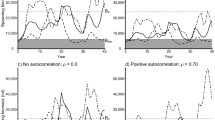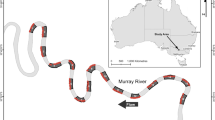Abstract
The Atlantic horsehoe crab,Limulus polyphemus, is harvested by the biomedical industry for Limulus Amoebocyte Lysate (LAL) a blood compound used to detect endotoxins, for scientific research on vision, and as bait for the eel and conch fisheries. They are also subject to sources of natural mortality such as consumption of eggs by shorebirds and stranding. Recently there has been growing concern over possible declines inLimulus populations along the east coast of the United States. We have used stage-structured matrix modeling to improve our understanding ofLimulus population dynamics in three Cape Cod estuaries (Stage Harbor, Pleasant Bay, and Barnstable Harbor) with differing harvest pressures. The results suggest that a low level of harvest is sustainable, particularly if timing and size-specificity of the harvest are taken into consideration. The model also suggests that efforts should be made to avoid harvesting crabs prior to sexual maturity, as the population growth rate is more sensitive to changes in survival rate of older juveniles than of other stages. The information the model provides could assist local and regional fisheries managers in establishing appropriate regulations for the horseshoe crab fishery.
Similar content being viewed by others
Literature Cited
Armsworth, P. R. andJ. E. Roughgarden. 2005. The impact of directed versus random movement on population dynamics and biodiversity patterns.The American Naturalist 165:449–465.
Atlantic States Marine Fisheries Commission (ASMFC). 1998. Interstate Fishery Management Plan for Horseshoe Crab. Fishery Management Report No. 32, ASMFC, Washington, D.C.
Atlantic States Marine Fisheries Commission (ASMFC). 2000. Interstate Fishery Management Plan for Horseshoe Crab Addendum I. Fishery Management Report No. 32a, ASMFC, Washington, D.C.
Atlantic States Marine Fisheries Commission (ASMFC). 2004. Interstate Fishery Management Plan for Horseshoe Crab Addendum III. Fishery Management Report No. 32c, ASMFC, Washington, D.C.
Berkson, J. andC. Shuster. 1999. The horseshoe crab: The battle for a true multiple-use resource.Fisheries Management 24:6–10.
Botton, M. andJ. Ropes. 1988. An indirect method, for estimating longevity of the horseshoe crab (Limulus polyphemus) based on epifaunal slipper shells (Crepidula fornicata).Journal of Shellfish Research 7:407–412.
Botton, M. L. andR. E. Loveland. 1989. Reproductive risk: High mortality associated with spawning by horseshoe crabs (Limulus polyphemus) in Delaware Bay, USA.Marine Biology 101:143–151.
Brewster-Geisz, K. K. andT. J. Miller. 2000. Management of the sandbar shark,Carcharhinus plumbeus: Implications of a stagebased model.Fishery Bulletin 98:236–249.
Bulte, E. H. andG. C. van Kooten. 1999. Metapopulation dynamics and stochastic bioeconomic modeling.Ecological Economics 30:293–299.
Carmichael, R. H., D. Rutecki, andI. Valiela. 2003. Abundance and population structure of the Atlantic horseshoe crabLimulus polyphemus in Pleasant Bay, Cape Cod.Marine Ecology Progress Series 246:225–239.
Castro, G. andJ. P. Meyers. 1993. Shorebird predation on eggs of horseshoe crabs during spring stopover on Delaware Bay.Auk 110:927–934.
Caswell, H. 2000. Matrix Population Models, 2nd edition. Sinauer Associates, Inc. Sunderland, Massachusetts.
Casell, H. andM. C. Trevisan. 1994. Sensitivity analysis of periodic matrix models.Ecology 75:1299–1303.
Crouse, D. T., L. B. Crowder, andH. Caswell. 1987. A stage-based population model for loggerhead sea turtles and implications for conservation.Ecology 68:1412–1423.
Dekroon, H., A. Plaisier, J. van Groenendael, andH. Caswell. 1986. Elasticity: The relative contribution of demographic parameters to population growth rate.Ecology 67:1427–1431.
Ennis, G. P. 1985. An assessment of the impact of size limit and exploitation rate changes on egg production in a Newfoundland lobster population.North American Journal of Fisheries Management 5:86–90.
Ennis, G. P. andM. J. Fogarty. 1997. Recruitment overfishing reference point for the American lobster,Homarus americanus.Marine and Freshwater Research 48:1029–1034.
Grady, S. P. 2006. Population dynamics of the horseshoe crab,Limulus polyphemus, on Cape Cod: Field data and model simulations of the effects of harvest. Ph.D. Dissertation., Boston University Marine Program, Woods Hole, Massachusetts.
Grady, S. P., D. Rutecki, R. H. Carmichael, andI. Valiela. 2001. Age structure of the Pleasant Bay population ofCrepidula fornicata: A possible tool for estimating horseshoe crab age.Biological Bulletin 201:296–297.
Han-Lin, L. andA. Bradbury. 1998. A modified catch-at-size analysis model for a red sea urchin (Strongylocentrotus franciscanus) population.Proceedings of the North Pacific Symposium on Invertebrate Stock Assessment and Management 125:85–96.
Heppell, S. S., H. Caswell, andL. B. Crowder. 2000. Life histories and elasticity patterns: Perturbation analysis for species with minimal demographic data.Ecology 81:654–665.
James-Pirri, M. J., K. Tuxbury, S. F. Marino, and S. Koch 2002. Population demographics and spawning densities of the horseshoe crab,Limulus polyphemus, within Cape Cod National Seashore, Cape Cod Bay and Monomoy National Wildlife Refuge, Massachusetts. Final Report to National Park Service, Cape Cod National Seashore, Massachusetts.
Jamieson, G. S., A. Phillips, andB. D. Smith. 1998. Implications of selective harvests in Dungeness crab (Cancer magister) fisheries.Proceedings of the North Pacific Symposium on Invertebrate Stock Assessment and Management 125:309–321.
Jonzén, N., J. R. Rhodes, andH. P. Possingham. 2005. Trend detection in source-sink systems: When should sink habitats be monitored?Ecological Applications 15:326–334.
Leiva, G. E. andJ. C. Castilia. 2001. A review of the world marine gastropod fishery: Evolution of catches, management, and the Chilean experience.Reviews in Fish Biology and Fisheries 11:283–300.
Leschen, A. S., S. P. Grady, andI. Valiela. 2006. Fecundity and spawning of the Atlantic horseshoe crab,Limulus polyphemus, in Pleasant Bay, Cape Cod, Massachusetts, USA.Marine Ecology 27:54–65.
Little, S. A. andW. H. Watson III. 2005. Differences in the size at maturity of female American lobsters (Homarus americanus) captured throughout the range of the offshore fishery.Journal of Crustacean Biology 25:585–592.
Loher, T., P. S. Hill, G. Harrington, andE. Cassano. 1998. Management of Bristol Bay Red King Crab: A critical intersections approach to fisheries management.Reviews in Fisheries Science 6:169–251.
Loveland, E., M. Botton, andC. Shuster. 1996. Life history of the American horseshoe crab (Limulus polyphemus L.) in Delaware Bay and its importance as a commercial resource, p. 15–22.In J. Farrell and C. Martin (eds.), Proceedings of the Horseshoe Crab Forum: Status of the Resource. University of Delaware Sea Grant Program, Newark, Delaware.
Miller, T. J. 2001. Matrix-based modeling of blue crab population dynamics with applications to the Chesapeake Bay.Estuaries 24:535–544.
Novitsky, T. J. 1984. Monitoring and validation of high purity water systems with theLimulus amoebocyte lysate test for pyrogens.Pharmaceutical Engineering 4:21–33.
Orensanz, J. M., C. M. Hand, A. M. Parma, J. Valero, andR. Hilbom. 2004. Precaution in the harvest of Methuselah's clams—Difficulty of getting timely feedback from slow-paced dynamics.Canadian Journal of Fisheries and Aquatic Sciences 61:1355–1372.
Penn, D. andH. J. Brockmann. 1995. Age-based stranding and righting in male horseshoe crabs,Limulus polyphemus.Animal Behavior 49:1531–1539.
Perry, R. I., Z. Zhang, andR. Harbo. 2002. Development of the green sea urchin (Stronglocentrotus droebachiensis) fishery in British Columbia, Canada—Back from the brink using a precautionary framework.Fisheries Research 55:253–266.
Prager, M. J., J. McConaugha, C. M. Jones, andP. Geer. 1990. Fecundity of blue crab,Callinectes sapidus, in Chesapeake Bay.Bulletin of Marine Science 46:170–179.
Read, A. F. andP. H. Harvey. 1989. Life history differences among the eutherian radiations.Journal of Zoology 219:329–353.
Rudloe, A. 1983. The effect of heavy bleeding on mortality of the horseshoe crab,Limulus polyphemus, in the natural environment.Journal of Invertebrate Pathology 42:167–176.
Rutecki, D. A., R. H. Carmichael, andI. Valiela. 2004. Magnitude of harvest of Atlantic horseshoe crabs,Limulus polyphemus, in Pleasant Bay, MA.Estuaries 27:179–187.
Salinas, R. A., S. Lenhart, andL. J. Gross. 2005. Control of a metapopulation harvesting model for black bears.Natural Resource Modeling 18:307–321.
Salthaug, A. andD. M. Furevik. 2004. Size selection of red king crabs,Paralithodes camtschaticus, in traps with escape openings.Sarsia 89:184–189.
Sanchirico, J. N. andJ. E. Wilen. 2001. A bioeconomic model of marine reserve creation.Journal of Environmental Economics and Management 42:257–276.
Sekiguchi, K. 1988. Biology of Horseshoe Crabs. Science House Co, Tokyo, Japan.
Shuster, C. 1982. A pictorial review of the natural history and ecology of the horseshoe crab,Limulus polyphemus, with reference to other Limulidae, p. 1–52.In J. Bonaventura, C. Bonaventura, and S. Tesh (eds.), Physiology and Biology of Horseshoe Crabs, Volume 81. Alan R. Liss, New York.
Shuster, C. 1996. Abundance of adult horseshoe crabs,Limulus polyphemus, in Delaware Bay, 1850–1990, p. 5–14.In J. Farrell and C. Martin (eds.), Proceedings of the Horseshoe Crab Forum: Status of the Resource. University of Delaware Sea Grant Program, Newark, Delaware.
Shuster, Jr.,C. N. andM. L. Botton. 1985. A contribution to the population of horseshoe crabs,Limulus polyphemus (L.) in Delaware Bay.Estuaries 8:363–372.
Smith, S. J. andB. Sainte-Marie. 2004. Biological reference points for invertebrate fisheries: Introduction.Canadian Journal of Fisheries and Aquatic Sciences 61:1303–1306.
Stockhausen, W. T., R. N. Lipcius, andB. M. Hickey. 2000. Joint effects of larval dispersal, population regulation, marine reserve design, and exploitation on production and recruitment in the Caribbean spiny lobster.Bulletin, of Marine Science 66:957–990.
Tanner, J. E. 2001. Influence of harvest refugia on penaeid prawn population dynamics and sustainable catch.Canadian Journal of Fisheries and Aquatic Sciences 58:1794–1804.
Tuck, G. N. andH. P. Possingham. 2000. Marine protected areas for spatially structured exploited stocks.Marine Ecology Progress Series 192:89–101.
Walls, E. A. andJ. M. Berkson. 2000. Effect of blood extraction on the mortality of the horseshoe crab,Limulus polyphemus.Virginia Journal of Science, 51:195–198.
Wenner, E. andM. Thompson. 2000. Evaluation of harvesting impacts and population trends forLimulus polyphemus in South Carolina. Final report to the National Oceanographic and Atmospheric Administration. National Marine Fisheries Service, Southeast Regional Office, St. Petersburg, Florida.
Source of Unpublished Materials
Germano, F. personal communication. Massachusetts Division of Marine Fisheries, 50A Portside Drive, Pocasset, Massachusetts 02559.
Author information
Authors and Affiliations
Corresponding author
Rights and permissions
About this article
Cite this article
Grady, S.P., Valiela, I. Stage-structured matrix modeling and suggestions for management of atlantic horseshoe crab,Limulus polyphemus, populations on cape cod, massachusetts. Estuaries and Coasts: J ERF 29, 685–698 (2006). https://doi.org/10.1007/BF02784293
Received:
Revised:
Accepted:
Issue Date:
DOI: https://doi.org/10.1007/BF02784293




